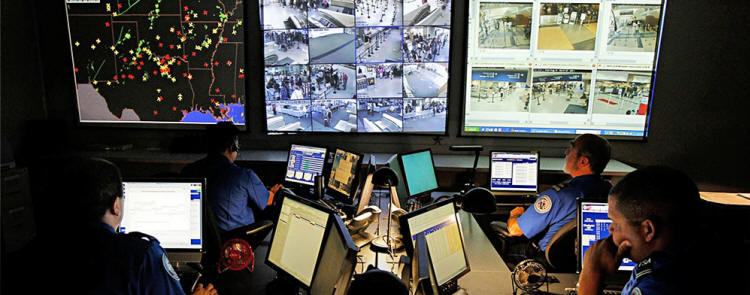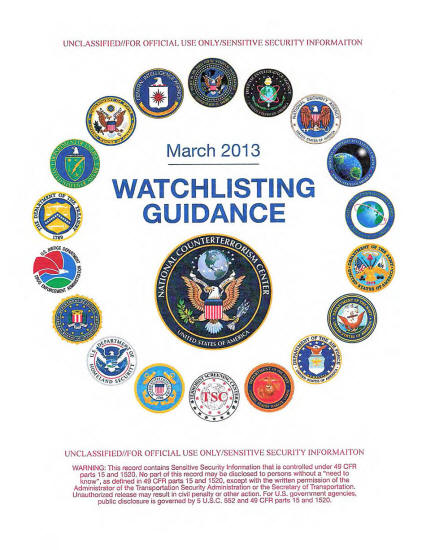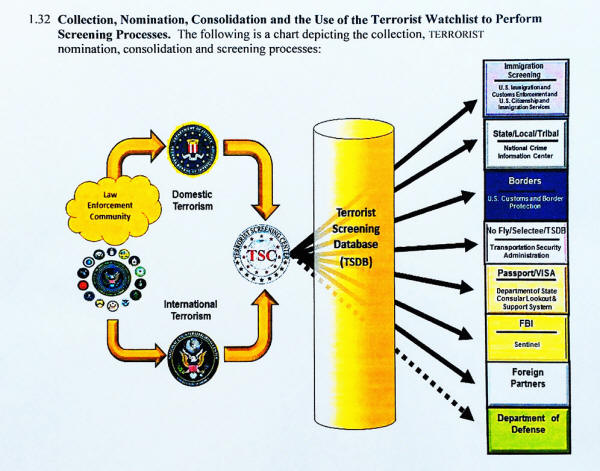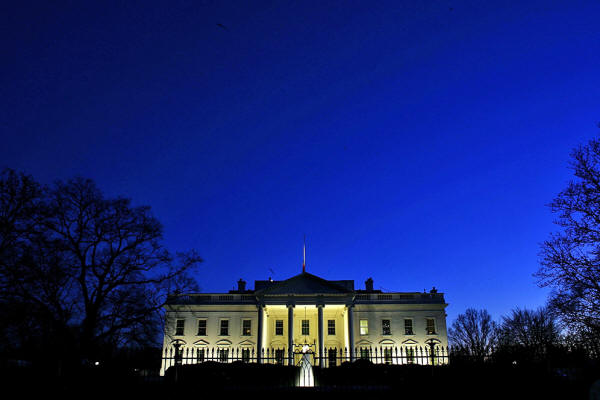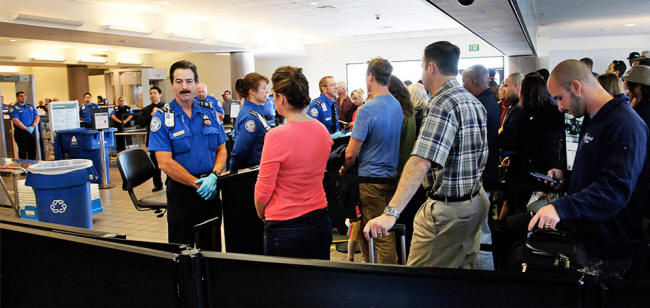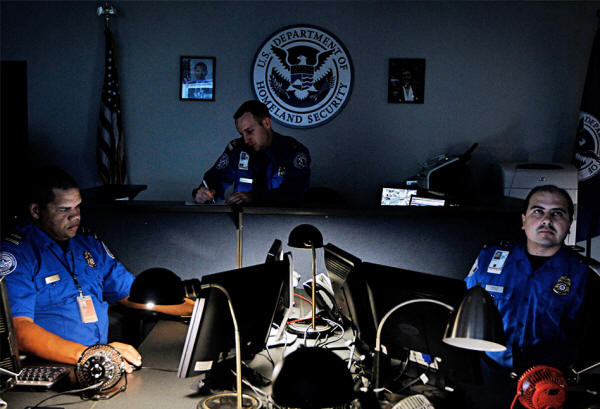|
Josh Begley, Lynn Dombek, and Peter
Maass contributed to this story
The
Obama administration
has quietly approved a substantial expansion of the terrorist watchlist system, authorizing a secret process that requires neither
"concrete facts" nor "irrefutable evidence" to
designate an American
or foreigner as a terrorist, according to a key government document
obtained by The Intercept.
The new guidelines allow individuals to be designated as representatives of terror organizations without any evidence they are actually connected to such organizations, and it gives a single White House official the unilateral authority to place entire "categories" of people the government is tracking onto the no fly and selectee lists.
It broadens the authority
of government officials to "nominate" people to the watchlists based
on what is vaguely described as "fragmentary information." It also
allows for dead people to be watchlisted.
In May, Attorney General Eric Holder even invoked the state secrets privilege to prevent watchlisting guidelines from being disclosed in litigation launched by an American who was on the no fly list.
In an affidavit, Holder called them a "clear roadmap" to the government's terrorist-tracking apparatus, adding:
March 2013 Watchlisting Guidance
Emblazoned with the crests of 19 agencies, it offers the most complete and revealing look into the secret history of the government's terror list policies to date.
It reveals a confounding and convoluted system filled with exceptions to its own rules, and it relies on the elastic concept of "reasonable suspicion" as a standard for determining whether someone is a possible threat.
Because the government tracks "suspected terrorists" as well as "known terrorists," individuals can be watchlisted if they are suspected of being a suspected terrorist, or if they are suspected of associating with people who are suspected of terrorism activity.
Hina Shamsi, who reviewed the document, added,
The document's definition of "terrorist" activity includes actions that fall far short of bombing or hijacking.
In addition to expected crimes, such as assassination or hostage-taking, the guidelines also define destruction of government property and damaging computers used by financial institutions as activities meriting placement on a list.
They also define as
terrorism any act that is "dangerous" to property and intended to
influence government policy through intimidation.
It can also be counterproductive.
When resources are devoted to tracking people who are not genuine risks to national security, the actual threats get fewer resources - and might go unnoticed.
The fallout is personal too.
There are severe consequences for people unfairly labeled a terrorist by the U.S. government, which shares its watchlist data with local law enforcement, foreign governments, and "private entities."
Once the U.S. government secretly labels you a terrorist or terrorist suspect, other institutions tend to treat you as one. It can become difficult to get a job (or simply to stay out of jail). It can become burdensome - or impossible - to travel.
And routine encounters with law enforcement can turn into ordeals.
A chart from the
"March 2013 Watchlisting Guidance"
Of course, the problem is
that the "known or suspected terrorist" might just be an ordinary
citizen who should not be treated as a menace to public safety.
On 9/11, the government's list of people barred from flying included just 16 names. Today, the no fly list has swelled to tens of thousands of "known or suspected terrorists" (the guidelines refer to them as KSTs).
The selectee list subjects people to extra scrutiny and questioning at airports and border crossings. The government has created several other databases, too.
The largest is the Terrorist Identities Datamart Environment (TIDE), which gathers terrorism information from sensitive military and intelligence sources around the world.
Because it contains classified information that cannot be widely distributed, there is yet another list, the Terrorist Screening Database, or TSDB, which has been stripped of TIDE's classified data so that it can be shared.
When government officials refer to "the watchlist," they are typically referring to the TSDB.
In a statement, a spokesman for the National Counterterrorism Center told The Intercept that,
He added that U.S. citizens are afforded extra protections to guard against improper listing, and that no one can be placed on a list solely for activities protected by the First Amendment.
A representative of the
Terrorist Screening Center did not respond to a request for comment. The system has been criticized for years.
"Concrete facts are not
necessary"
Different types of data on suspected terrorists are referred to as,
The names of suspected terrorists are passed along a bureaucratic ecosystem of,
And "upgrade," usually a happy word for travelers, is repurposed to mean that an individual has been placed on a more restrictive list.
The heart of the document revolves around the rules for placing individuals on a watchlist.
It sets a low standard - "reasonable suspicion" - for placing names on the watchlists, and offers a multitude of vague, confusing, or contradictory instructions for gauging it.
In the chapter on "Minimum Substantive Derogatory Criteria" - even the title is hard to digest - the key sentence on reasonable suspicion offers little clarity:
The rulebook makes no effort to define an essential phrase in the passage - "articulable intelligence or information."
After stressing that hunches are not reasonable suspicion and that "there must be an objective factual basis" for labeling someone a terrorist, it goes on to state that no actual facts are required:
While the guidelines nominally prohibit nominations based on unreliable information, they explicitly regard "uncorroborated" Facebook or Twitter posts as sufficient grounds for putting an individual on one of the watchlists.
There are a number of loopholes for putting people onto the watchlists even if reasonable suspicion cannot be met.
One is clearly defined:
But another loophole is quite broad - "associates" who have a defined relationship with a suspected terrorist, but whose involvement in terrorist activity is not known.
A third loophole is broader still - individuals with "a possible nexus" to terrorism, but for whom there is not enough "derogatory information" to meet the reasonable suspicion standard.
Americans and foreigners can be nominated for the watchlists if they are associated with a terrorist group, even if that group has not been designated as a terrorist organization by the U.S. government.
They can also be treated as "representatives" of a terrorist group even if they have,
The guidelines do helpfully note that certain associations, such as providing janitorial services or delivering packages, are not grounds for being watchlisted.
The nomination system appears to lack meaningful checks and balances.
Although government officials have repeatedly said there is a rigorous process for making sure no one is unfairly placed in the databases, the guidelines acknowledge that all nominations of "known terrorists" are considered justified unless the National Counterterrorism Center has evidence to the contrary.
In a recent court filing, the government disclosed that there were 468,749 KST nominations in 2013, of which only 4,915 were rejected - a rate of about one percent.
The rulebook appears to invert the legal principle of due process, defining nominations as "presumptively valid."
Profiling categories of people
While the nomination process appears methodical on paper, in practice there is a shortcut around the entire system.
Known as a "threat-based expedited upgrade," it gives a single White House official the unilateral authority to elevate entire "categories of people" whose names appear in the larger databases onto the no fly or selectee lists.
This can occur, the guidelines state, when there is a "particular threat stream" indicating that a certain type of individual may commit a terrorist act.
This extraordinary power for "categorical watchlisting" - otherwise known as profiling - is vested in the assistant to the president for homeland security and counterterrorism, a position formerly held by CIA Director John Brennan that does not require Senate confirmation.
The rulebook does not indicate what "categories of people" have been subjected to threat-based upgrades.
It is not clear, for example, whether a category might be as broad as military-age males from Yemen. The guidelines do make clear that American citizens and green card holders are subject to such upgrades, though government officials are required to review their status in an "expedited" procedure.
Upgrades can remain in effect for 72 hours before being reviewed by a small committee of senior officials.
If approved, they can remain in place for 30 days before a renewal is required, and can continue "until the threat no longer exists."
The National Counterterrorism Center declined to provide any details on the upgrade authority, including how often it has been exercised and for what categories of people.
Pocket litter and scuba gear
The guidelines provide the clearest explanation yet of what is happening when Americans and foreigners are pulled aside at airports and border crossings by government agents.
The fifth chapter, titled "Encounter Management and Analysis," details the type of information that is targeted for collection during "encounters" with people on the watchlists, as well as the different organizations that should collect the data.
The Department of Homeland Security is described as having the largest number of encounters, but other authorities, ranging from the State Department and Coast Guard to foreign governments and "certain private entities," are also involved in assembling "encounter packages" when watchlisted individuals cross their paths.
The encounters can be face-to-face meetings or electronic interactions - for instance, when a watchlisted individual applies for a visa.
In addition to data like fingerprints, travel itineraries, identification documents and gun licenses, the rules encourage screeners to acquire,
The digital information singled out for collection includes,
All of the information is then uploaded to the TIDE database.
Screeners are also instructed to collect data on any "pocket litter," scuba gear, EZ Passes, library cards, and the titles of any books, along with information about their condition - "e.g., new, dog-eared, annotated, unopened."
Business cards and conference materials are also targeted, as well as "anything with an account number" and information about any gold or jewelry worn by the watchlisted individual.
Even "animal information" - details about pets from veterinarians or tracking chips - is requested. The rulebook also encourages the collection of biometric or biographical data about the travel partners of watchlisted individuals.
The list of government entities that collect this data includes the U.S. Agency for International Development, which is neither an intelligence nor law-enforcement agency.
As the rulebook notes, USAID funds foreign aid programs that promote environmentalism, health care, and education.
USAID, which presents itself as committed to fighting global poverty, nonetheless appears to serve as a conduit for sensitive intelligence about foreigners.
According to the guidelines,
The guidelines do not disclose the volume of names provided by USAID, the type of information it provides, or the number and duties of the "USAID intelligence analysts."
A USAID spokesman told The Intercept that,
He stated that since 2007, the agency has checked,
Death and the watchlist
The government has been widely criticized for making it impossible for people to know why they have been placed on a watchlist, and for making it nearly impossible to get off.
The guidelines bluntly state that,
But the courts have taken exception to the official silence and footdragging:
The difficulty of getting off the list is highlighted by a passage in the guidelines stating that an individual can be kept on the watchlist, or even placed onto the watchlist, despite being acquitted of a terrorism-related crime.
The rulebook justifies this by noting that conviction in U.S. courts requires evidence beyond a reasonable doubt, whereas watchlisting requires only a reasonable suspicion.
Once suspicion is raised, even a jury's verdict cannot erase it. Not even death provides a guarantee of getting off the list.
The guidelines say the names of dead people will stay on the list if there is reason to believe the deceased's identity may be used by a suspected terrorist - which the National Counterterrorism Center calls a "demonstrated terrorist tactic."
In fact, for the same reason, the rules permit the deceased spouses of suspected terrorists to be placed onto the list after they have died.
For the living, the process of getting off the watchlist is simple yet opaque.
A complaint can be filed through the Department of Homeland Security Traveler Redress Inquiry Program, which launches an internal review that is not subject to oversight by any court or entity outside the counterterrorism community.
The review can result in removal from a watchlist or an adjustment of watchlist status, but the individual will not be told if he or she prevails.
The guidelines highlight one of the reasons why it has been difficult to get off the list - if multiple agencies have contributed information on a watchlisted individual, all of them must agree to removing him or her.
If a U.S. citizen is placed on the no fly list while abroad and is turned away from a flight bound for the U.S., the guidelines say they should be referred to the nearest U.S. embassy or consulate, which is prohibited from informing them why they were blocked from flying.
According to the rules, these individuals can be granted a "One-Time Waiver" to fly, though they will not be told that they are traveling on a waiver.
Back in the United States, they will be unable to board another flight.
The document states that nominating agencies are "under a continuing obligation" to provide exculpatory information when it emerges. It adds that the agencies are expected to conduct annual reviews of watchlisted American citizens and green card holders.
It is unclear whether foreigners - or the dead - are reviewed at the same pace.
As the rulebook notes,
Photo credits: TSA: G.J. McCarthy/Dallas Morning News/Corbis (2); Guidance: Josh Begley; White House: Win McNamee/Getty Images; Airport: Nick Ut/AP Photo
|


